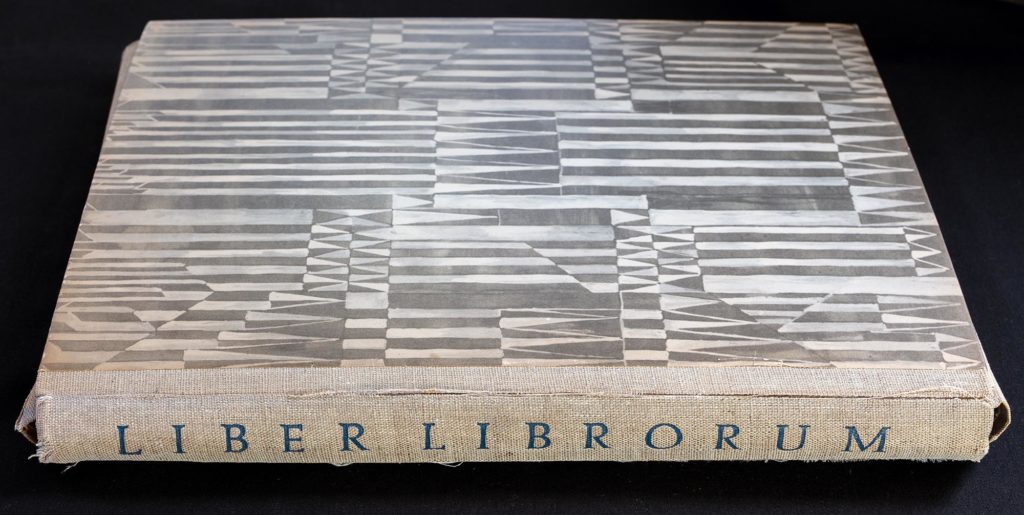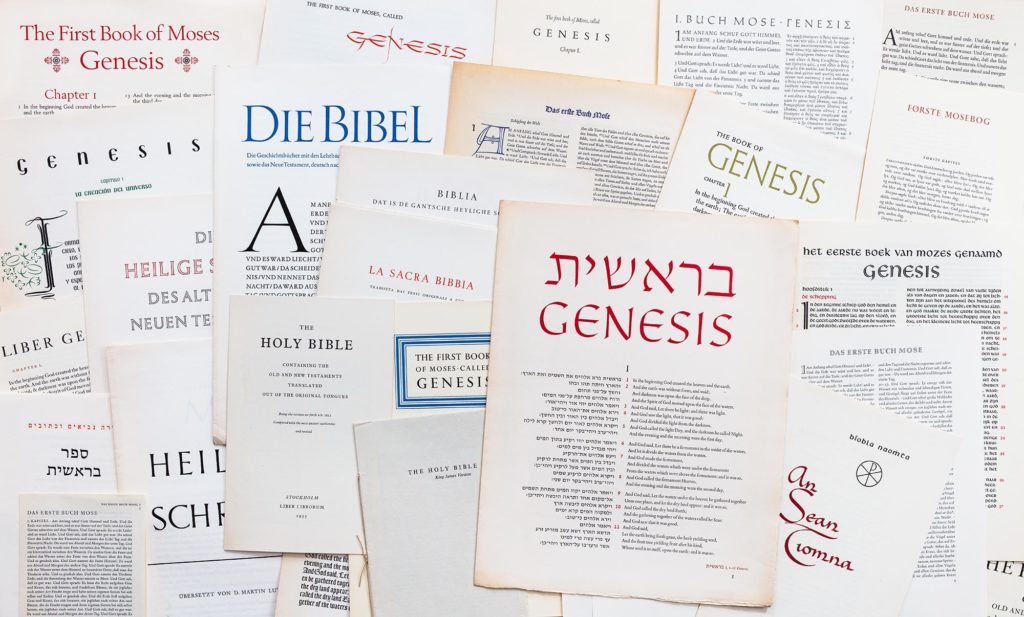Liber Librorum, a portfolio of Bible designs by international book designers, distributed by the Royal Library, Stockholm, in 1955.
Liber Librorum began as an invitation from a committee, Paul A. Bennet, Francis Meynell, C. Volmer Nordlunde, Raúl M. Rosarivo, Maximilien Vox, Bror Zachrisson and Hermann Zapf, to a select group of book designers to participate in a group project to commemorate the 500th anniversary of the printing of the Gutenberg Bible. The committee and the participants consisted of men from Argentina, Austria, Canada, Denmark, France, Germany, Great Britain, Holland, Ireland, Israel, Norway, Spain, Sweden, Switzerland and America. Each participant was charged with creating “his individual solution of the typographic problem of the Bible.”1Bennett, Paul et al., Liber Librorum 1955, p. 1. Stockholm: N. O. Mauritzons Boktyckeri. After paying a $10 entrance fee, participants were expected to donate their time and materials. Thirty-nine designers produced 43 designs, with non-Latin alphabets (Gaelic, Greek and Hebrew) used in just four. (Henri Friedlaender provided one of the two Hebrew exemplars.) Each supplied 1500 prints of their work and received 15 finished portfolios. The committee gave 200 portfolios to religious, educational and cultural institutions and arranged for 500 to be sold commercially in order to offset the costs of assembly, boxing and shipping. In case of monetary gain, the proceeds were to go to Albert Schweizer’s Lambarene Hospital. Sales were not entirely robust, but in the end, Dr. Schweizer received two payments totaling £375.
Ismar David answered the initial invitation enthusiastically, but asked two questions.2David, Ismar, letter to Bror Zachrisson, February 19, 1955. Ismar David papers, box 4, folder 89, Cary Graphic Arts Collection, RIT. To the first about using illustrations, Zachrisson’s secretary responded: “The Liber Librorum is not conceived as an illustrated project.”3Undated letter to Ismar David. Ismar David papers, box 4, folder 89, Cary Graphic Arts Collection, RIT. To the second, as to whether the deadline could be extended, Zachrisson acceded, and wrote: “As there will be probably some delays in the last minutes, let us agree to November 15. We want you indeed to participate. Please do not inform other participants of this crooked arrangement.” (How often and with how many participants must he have used this line…?) Hortense Mendel approached Harold Plaut of Intertype about sponsorship, telling him that the budget was [$]750 (if possible 1000 to take care of eventualities),4Mendel, Hortense, notes. David papers, box 4, folder 89, Cary Graphic Arts Collection, RIT. but Intertype declined.
For his innovative bilingual design, David chose Bembo, “one of the beautiful Monotoype faces…”5Mendel, Hortense, letter to Joseph Schwartz at Westcott & Thompson, August 16, 1955. Ismar David papers, box 4, folder 89, Cary Graphic Arts Collection, RIT. and his own newly-released David Hebrew. Clarke & Way, under the name Thistle Press, handset the Hebrew type, which had been cast on a Thompson caster. (David gave the resulting metal type to the Wronkers and it later made its way into the hands of Yehuda Miklaf.) The 1500 copies designated for Liber Librorum were shipped on November 23. An additional 5 copies had to be airmailed to Stockholm in order to be included in exhibitions at the Royal Library and the universities of Uppsala, Gothenburg and Lund. The Davids also gave or mailed the Genesis pages to an array of friends, family, professional associates and potential clients in the United States and Israel.



























